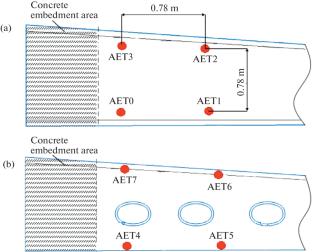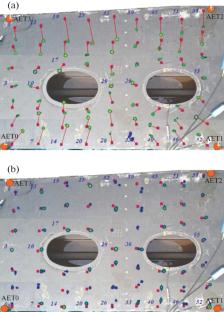复合材料飞机翼箱静载荷下缺陷声发射定位的解析和表法研究
摘要
本文介绍了某型飞机机翼箱的声发射测试结果。负载以10为一个步骤进行更改% of its maximum value. Before loading, the control zones consisting of four piezoelectric acoustic emission transducers were calibrated. In order to reduce the influence of anisotropy and design features of the wing box on the errors in defect location, a new technique consisting of analytical and tabular methods was developed. In the analytical method, the coordinates of defects were calculated using three sensors of a piezoantenna, and the location error included random and systematic components. Inaccurate determination of the difference in the times of signal arrival at the sensors of the piezoantenna was the main source of the random component of the error. The complexity of the design influenced the appearance of a systematic error. At the same time, the features of the test object hampered the rectilinear propagation of sound waves. When using the tabular method, the wing box structure was divided into a number of zones and the matrix of correspondence between the difference in signal arrival times and the coordinates of the selected cells was calculated. It was shown that the number of signals localized using the tabular method is bigger than that using the analytical method. Practical application of the developed location method showed that the average value of the reduced error decreased twofold when calculating the \(X\)-coordinate and sixfold when calculating the \(Y\)-coordinate. This made it possible to reduce location errors associated with the location of the calibration points on the structure. If the location error of signals exceeded the permissible value determined by the cell size, they were excluded from further consideration as nonlocalized.


The article presents the results of acoustic emission testing of an aircraft wing box made of composite material ACM 102 130 C UD. The load was changed in steps of 10% of its maximum value. Before loading, the control zones consisting of four piezoelectric acoustic emission transducers were calibrated. In order to reduce the influence of anisotropy and design features of the wing box on the errors in defect location, a new technique consisting of analytical and tabular methods was developed. In the analytical method, the coordinates of defects were calculated using three sensors of a piezoantenna, and the location error included random and systematic components. Inaccurate determination of the difference in the times of signal arrival at the sensors of the piezoantenna was the main source of the random component of the error. The complexity of the design influenced the appearance of a systematic error. At the same time, the features of the test object hampered the rectilinear propagation of sound waves. When using the tabular method, the wing box structure was divided into a number of zones and the matrix of correspondence between the difference in signal arrival times and the coordinates of the selected cells was calculated. It was shown that the number of signals localized using the tabular method is bigger than that using the analytical method. Practical application of the developed location method showed that the average value of the reduced error decreased twofold when calculating the \(X\)-coordinate and sixfold when calculating the \(Y\)-coordinate. This made it possible to reduce location errors associated with the location of the calibration points on the structure. If the location error of signals exceeded the permissible value determined by the cell size, they were excluded from further consideration as nonlocalized.

 求助内容:
求助内容: 应助结果提醒方式:
应助结果提醒方式:


